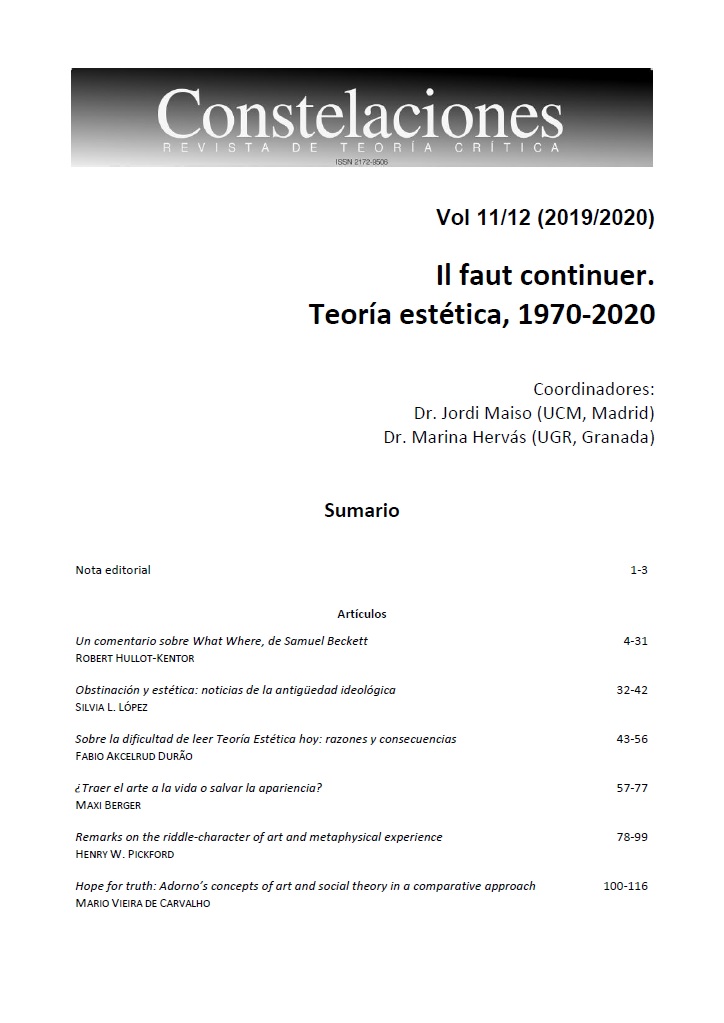A Comment on Samuel Beckett's What Where
Keywords:
Samuel Beckett, What Where, FormAbstract
An art work is a set of instructions for breaking a promise. The exact same instructions must no less stipulate this promise. This is incomparably the case in Samuel Beckett's work.Written for the stage soon after the completion of Beckett's major efforts for television and incorporating elements of it, What Where (1983) was his final work for the theater. Of all that might be said about the play, however, and there is considerably more to say, not a word of it proves ipso facto that it works on stage. As Beckett wrote his friend, the novelist Kay Boyle, 'Just finished a short piece—theatre—for the Graz Autumn Festival, to my dissatisfaction'. Samuel Beckett's last work for the theater was indeed a failure, but a failure of an extraordinarily high order. How the play could and did fail and all the same be the achievement it is, is the topic of the following commentary.
Downloads
References
ADORNO, Theodor W. (1998): Aesthetic Theory, Minnesota, University of Minnesota Press.
BECKETT, Samuel (1984): Collected Shorter Plays, Nueva York, Faber & Faber.
BECKETT, Samuel (2016): The Letters of Samuel Beckett. Vol. 4 1966-1989, edición de G. Craig, M. D. Fehsenfeld, D. Gunn y L. M. Overbeck, Cambridge, Cambridge University Press.
BENJAMIN, Walter (1977): The Origin of German Tragic Drama, Londres, New Left Books.
CARSON, Anne (2005): If Not, Winter. Fragments of Sapho, Nueva York, Random House.
COHN, Ruby (2005): A Beckett Canon, Ann Arbor, University of Michigan Press.
GUSSOV, Mel (1983): "Theater: Three Short Plays By Samuel Beckett", New York Times, June 16 1983, p. 18.
HARRISON, Daniel (2000): "Tolling Time", MTO, volumen 6, No. 4, October 2000.
HEIGHES, Simon (1986): notas al Mesías de Georg Friedrich Haendel, dirigido por Harry Christopher, Hyperion Records, [CD] CDA66251/2, 1986.
KNOWLSON, James (1996): Damned to Fame. The Life of Samuel Beckett, Nueva York, Simon & Schuster.
MILLER, Arthur (1974): Death of a Salesman, Nueva York, Viking Press.
NIEBUHR, Reinhold (2015): Moral Man and Inmmoral Society, Nueva York, Westminster John Knox Press.
SALLE, David (2018): How To See, Nueva York, Norton.
STEVENS, Wallace (1997): Collected Poetry and Prose, Nueva York, Library of America.
SYLVESTER, David (1987): The Brutality of Fact. Interviews With Francis Bacon, Londres, Thames and Hudson.
VAN GOGH, Vincent (1969): Dear Theo, edición de Irving Stone, Nueva York.
Downloads
Published
How to Cite
Issue
Section
License
Authors who have publications with this journal accept the following terms:
1. Authors will retain their copyright and grant the journal the right of first publication of their work, which will be simultaneously subject to the License of recognition of Creative Commons CC BY-NC-SA 4.0 that allows third parties to share, redistribute and adapt the work provided it is for non-commercial purposes and its author and first publication in this journal is indicated.
2. Authors may adopt other non-exclusive distribution license agreements for the version of the published work (e.g., depositing it in an institutional electronic archive or publishing it in a monographic volume) provided that the initial publication in this journal is indicated.
3. Authors are permitted and encouraged to disseminate their work via the Internet (e.g., in institutional telematic archives or on their website) before and during the submission process, which can produce interesting exchanges and increase citations of the published work. (See The Effect of Open Access).
Data confidentiality
1. Constelaciones. Revista de Teoría Crítica guarantees that the data you send us will only be used to meet the requests made in this message.
2. Your data will not be passed on to third parties.
3. You may request that your data be removed from our records at any time.





